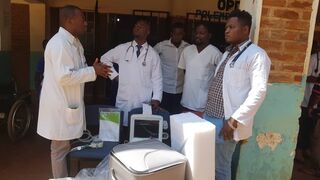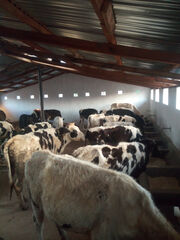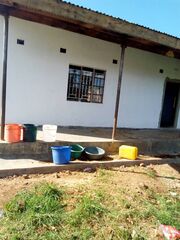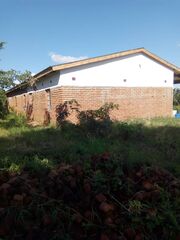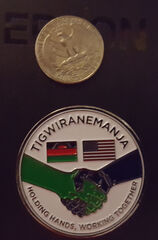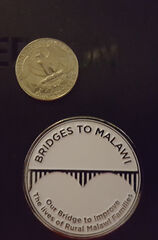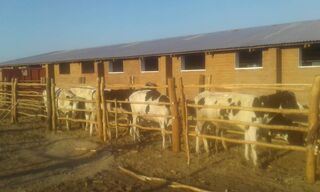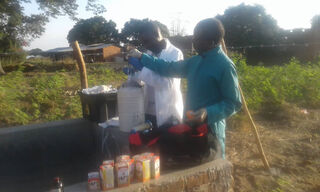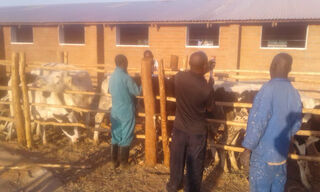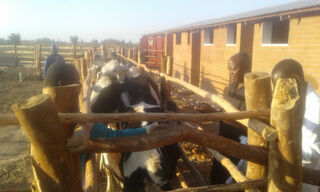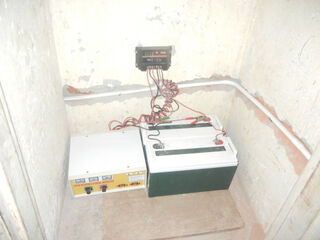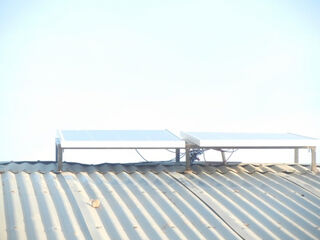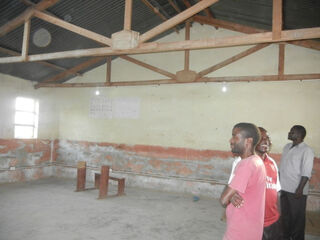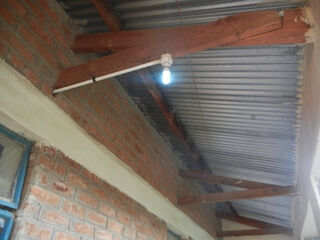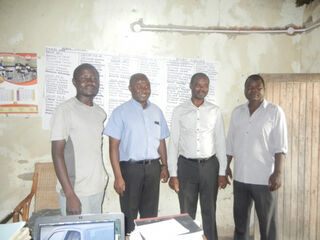The new ultrasound machine has arrived at St. Andrews!
Author: btmadmin
August 23, 2020
Covid-19: Here’s the latest from Malawi. First, the small COVID-19 outbreak in Mtunthama is over. The country of Malawi overall has seen 5,382 cases with 168 deaths. First case was reported on April 3rd and new cases have been trending down since August 12.
Dairy Project: Unfortunately our excitement over cow pregnancies was premature. None of the heifers are pregnant, apparently because the frozen semen we used had no viable sperm in it. We are in the process of acquiring more semen and ensuring that it has viable sperm at time of purchase and is handled properly so that viability is maintained throughout our transport, storage, and insemination process. Since we’re new at this, I think of such a minor setback as merely a learning opportunity.
Wello Water Wheels: 700 water wheels have been purchased along with the container that they will be shipped from Mumbai India. The ship is supposed to leave for Dar Es Salaam , Tanzania in the next 10 days, so hopefully the container will be in Mtunthama by mid-late September. The container will be used for a combination of storage, office space, and possibly, a small hydroponic project.
Bamboo: 6,000 bamboo saplings have been purchased and will be shipped from Zambia around Aug 27 with the plan that they will arrive in Mtunthama on Aug 28. They will be distributed for free by our sister organization K2TASO soon thereafter.
Ultrasound Probe: The convex array abdominal ultrasound probe for the Edan 60 Ultrasound machine we donated to St. Andrews in 2013 has broken and we were asked to replace it. After much research, we were able to find a replacement, which should arrive in Mtunthama next week.
Hydroponic/Aquaponic System: I have now successfully grown lettuce, radishes, bok choy, with very little effort, using the waste from 4 cichlids (fish native to Lake Malawi but very easy to obtain at PETCO) converted by bacteria to nitrates as the sole nutrient. I have also grown peas and tomatoes using this system but yields are lower than I’d like so far. I have also been able to grow carrots in a separate perlite hydroponic system. Peter Minjale is looking into acquiring 2 systems much larger systems (mine is only good for 51 plants).
Solar Powered Milk Chiller: A work in progress. Having trouble finding a company to provide us with a working system. Please contact me at lisse@massmed.org if you have any ideas about this, including the knowledge to convert a small freezer or refrigerator to solar.
Reforestation Project: 200,000 saplings are in the process of being planted as we speak.
July 28, 2020
Just wanted to give you all an update on our projects and COVID 19 in Mtunthama, Malawi where we work. There has been a small outbreak of COVID 19 there including 1 nurse from St. Andrews who was staying in the orphanage. She was never hospitalized and had apparently acquired it in Lilongwe. Her 36 close contacts in Mtunthama were all tested and were all negative. St. Andrews has seen 2 other cases, both referred to Kasungu District Hospital, 1 of whom died. 4 healthcare workers at the Mtunthama government clinic (not K2TASO) have also tested positive about 2 weeks ago and are all OK. Peter says the current total COVID cases in the Kasungu District are now at 51 with 1 death. Don’t know the numbers for the country altogether, but so far their mortality and infection rates seem to be well below ours.
In light of the above, Peter an I talk once a week about what to do about any and all of our projects. Thus far, he feels we should continue business as usual, so as money has become available, that’s how we’ve proceeded. So here’s the good news, and there’s plenty of it.
1) DAIRY PROJECT:
a) 15/30 cows have now been artificially inseminated and 5 are pregnant for certain. The others were done too recently to be tested. This means we will have milk production sometime in May.
b) The local Malawi agriculture government officers are so impressed with what we are doing that they asked if we could donate some Friesian bull semen “straws” ($2.50 apiece) to them. The want to start crossing Friesian genes with those of the local Malawi Zebu cattle because the Friesians produce about 10-15 Liters of milk a day while the Zebus produce only about 1-2 Liters. The Friesian milk is also much higher in fat and protein. This means that sometime in the future, between us and the government, the entire Kasungu District of 800,000 plus people could benefit from the consequent huge increase in nutrition and economic gain available to them. Pretty cool, huh?
c) The local government run veterinary school wants to start using our dairy project site as a place to send their students to learn best practices, including artificial insemination, because they have been so impressed with the work we are doing. Total expenditure ytd approximately $60,000
2) 700 Wello water wheels, which enable poor farm women to roll barrels full of water from river to farm by means of a lawn mower like handle attached to them are being shipped from Mumbai (they are made nearby) to Dar Es Salaam and thence to Mtunthama. This will make the lives of local farm women so much easier because they won’t have to carry water filled containers on their backs anymore. (see the Wello water wheel website for further details). Peter wanted us to purchase the 40 foot shipping container as well for storage, office, and possible hydroponic use, and we did that. Total cost will be approximately $29,300 (approximate because we don’t have import duty amount yet). They should arrive by mid Sept if all goes well.
3) 6,000 bamboo plants will be imported from Zambia at the end of August for donation to farmers at a cost of $15,000. This is in addition to the 4200 bamboo plants we have already given away grown from seeds purchased last year. The bamboo provides an excellent source of charcoal and animal fodder and thus will help combat deforestation.
4) Peter is in the process of planting 200,000 tree saplings at a cost of $6500. This will add to the over 70,000 trees which have survived from prior years of our reforestation.
5) We are in the process of giving away 300 more chickens (in addition to the 175 chickens we have already given away) as part of our other current pass-on program (the dairy project is one as well) at cost of $1650.
6) We have now drilled 3 new boreholes (wells) in different villages, including Chambwavi, where our the now completed secondary school girl’s hostel/dorm is located and hopes to drill 3 more this year (using money already allocated last year)
7) Our Land Lease (help to poor farmers), Micro-credit Bank, Free Care Fund (to help defray medical expenses), IT teaching, and Medication Donation projects are also continuing and making wonderful progress at an annual cost of about $18,000.
8) A hydroponic/aquaponic demonstration project (or 2) and 2 small solar powered milk chillers (refrigerators) for local farmers are also in the works. Cost $12,000
All pretty cool, huh? So when you’re feeling completely overwhelmed by COVID and economic downturns and racism, and Donald Trump, at least, I hope, I can brighten up your day a little.
Do we really have all the money for the above? Well, between Cindy and me, Doug Williams, Don Hangen, and many other generous donors, we’re close to what we need. But could use another $5,000 or so to be sure.
As part of our fundraising, we are offering for sale commemorative Bridges to Malawi coins designed by Sue Fitzgerald, NP at $25 apiece if you pick it up at my house, 7 Curley Drive, Hudson, MA and $30 apiece if you want me to mail one to you. They are really cool!
Hope you are all well and staying safe. My we all be vaccinated and fully employed and back in school and racially and economically just soon!
All our best to all of you and thanks so much for all you past, present, and future help and participation in our worthy cause.
June 9, 2020
May 21, 2020
Just finished skyping with Peter Minjale. We provided over $8,000 to help him prevent and combat COVID19. New measures have included the purchase of masks and PPE for healthcare providers and masks for patients when they are being seen in St. Andrews Hospital and K2TASO clinic. In addition Peter and his colleagues have been establishing hand washing stations in many villages and conducting educational workshops on the virus both for healthcare providers and villagers. As of today Malawi reports only 71 cases and 3 deaths. Peter says they can test and he has not yet, thank God, seen anyone with the disease. Some experts are saying that countries like Malawi, which have a very low proportion of people over 20, may do better than countries such as ours.
Peter also informs me that in the 10 or so villages we have provided Artemisia to there is almost no malaria! This includes the village of Makanda, where we did our first IRS treatment all those years ago. So the preventive tea made for the plant does work! Unfortunately, malaria is still quite common in the villages where Artemisia has not yet been made available. We hope to provide another 1500 plants this year.
Peter also sent me pictures of eggs (see agriculture section for pictures) from donated chickens and told me he plans to buy 200 more chickens for our pass-on program in the next week or so. He says we have so far helped provide extra income and protein for 35 families (approximately 245 people). Now we’ll be able to help 40-50 more families.
Peter also sent me pictures of Land Lease beneficiaries holding watermelons they grew from seed brought by us from the US (see pictures in the agriculture section). Peter says one farmer got 9 watermelons off a single plan, averaging 12-17 kgs per melon(26- lbs). He says that no one else is growing watermelons in the Kasungu East District besides our beneficiaries, but there is a great market and farmers can sell these for about $3-$4 apiece. This is just one crop and one example of how we’re helping these poorest of the poor farmers.
Finally, the biggest news! As we speak, we are in the process of purchasing 30 dairy heifers (mostly Holsteins) in Southern Malawi for our dairy project. The Malawi Ministry of Agriculture is very excited about our initiative and is assisting us with the cow transport. We hope to have the heifers transported to to our farm at Kasikidzi over the weekend. Our staff will take all necessary precautions to avoid getting or bringing COVID19 to Mtunthama. In the next few months we will have finished constructing facilities for processing the milk (minus refrigeration, yogurt making, and pasteurizing , which we hope to donate in about 9 months, if we can raise enough money to do so (it’ll cost about $60,000 altogether). The milk will provide protein and income for many farm families. (see pictures in agriculture)
November 13, 2019
Peter and Jacqueline Minjale just left the US for home after their first trip here ever. They landed in DC on Oct 5 and got a tour of the US including DC, Boston, a dairy farm in Wisconsin, Niagara Falls, Monument Valley, the Grand Canyon, Sedona, part of the Navajo Reservation, Tucson, San Francisco, and Yosemite. They shadowed me at work in my emergency department to see the difference between US and Malawi medicine. They gave fundraising talks to several groups while here, and also went to the Peter Yarrow concert. We constantly talked about Bridges to Malawi and how much we have accomplished (see below) and what our plans should be for 2020. They enjoyed their trip immensely and were very impressed with many things about our country, but especially with how well we care for our environment when compared to their country. We miss them very much already.
BTM Accomplishments:
Goat Pass-On Program: We donated 526 goats total between 2014 and 2018 when we stopped because we had maxed out the need for goats in our area. As of now, 3,126 farm families representing approximately 21,882 people have 15,630 goats altogether. FYI, the average goat yields approximately 10 times its body weight in milk in a year, providing almost 1 ton of protein for its family, as well as manure and ultimately meat and hides. And income to pay for high school education.
Land Lease Program: 4200 (640 farm families) have benefited from our program, and over 75% have been able to buy their own land as a result. More than 94% have graduated from the program because they don’t need our assistance anymore.
Micro-Credit Loan Program: 670 individual farm families (representing 4690 people) have benefited from a loan of up to a maximum of $25. Our payback rate is 98%, and most loans are paid back within 3 months. This program has enabled countless impoverished children to attend secondary school, a heretofore unattainable goal.
Cows and Ploughs Program: Our initially purchased herd of 24 cows has now increased to 39. These cows and plows are shared amongst the farmers of 5 different villages, benefiting thousands of people. Beneficiary farmers can now plow 5 acres in a day when it once took them 5-6 weeks to cultivate this much land by hand with a hoe. We have now provided 3 Magoye Rippers (conservation agriculture plows that plow a straight line rather than a wide furrow, thus preserving topsoil health) and the farmers using them have noticed a significant improvement in crop production. We plan to buy at least 2 more Magoye Rippers in 2020.
Chicken Pass-On Program: We have donated chickens to 35 households thus far, benefiting approximately 245 people. We began this program in 2018 and are ramping it up to benefit over a thousand people this year.
Reforestation Project: We planted a total of 70,000 trees between 2017 and 2018; 38,000 have survived, which is higher than the usual rate for such efforts. We hope to have planted an additional 80,000 trees this year.
Bamboo: 3400 of the 5800 seeds we planted have germinated and are currently being planted in an effort to combat deforestation while providing fodder, construction material, and economic opportunity to beneficiaries in addition to fuel.
Artemisia/Malaria Prevention: Over 300 households received plants and are drinking the tea with a consequent reduction in malaria rates in the villages where we’ve done this. We plan to ramp up this program in 2020
Laptops/Solar Power: We have donated laptops to a total of 8 high schools (64 computers in all) and have solar powered 7 schools, benefiting over 800 students so far. We will continue to donate more in 2020.
Chamwabvi Secondary School Girls’ Dorm: The old dilapidated girls’ dorm at this secondary school was levelled and replaced by a building partially constructed by our team during the April mission trip. The roof is now on the structure and finishing work is in process. We will be painting it in 2020 as part of next year’s mission trip.
Ergo Secondary School Mattress Donation: The 80 girls sleeping at the dorm in Ergo were sleeping on the floor or on the metal bedsprings of their beds; no mattresses were available. So we donated 60 mattresses and 20 more were donated by the Mooncatcher project, so the girls can now get a decent night’s sleep. We have heard that their grades are already better!
November 12, 2019
Thanks to all who attended our Peter Yarrow fundraiser concert and even more, to all of the dedicated incredible BTM board members who worked so very hard to make the concert happen. We netted over $4500, so the concert was a big success. Even if we hadn’t made any money at all, just being in the same room with Peter Yarrow and singing along with him “We Shall Overcome”,”Puff the Magic Dragon”, “Blowin’ in the Wind”, “Leavin’ on a Jet Plane”, and “Where Have All the Flowers Gone?” was an extraordinary experience! Thanks so much, Peter!
October 2019
Dear Friends of Bridges to Malawi,
I hope you’ve all had a wonderful summer. Thought I’d bring you up to date on our Bridges to Malawi trip in April, the current status of our programs, and a special need for funding some new projects. I also wanted to be sure that you are all aware that we are proudly sponsoring a benefit concert featuring Peter Yarrow, of Peter, Paul, and Mary, on Saturday Nov 9, 2019 at the Hudson Portuguese Club. General admission tickets are $40 apiece. Please visit our website for further information and to buy tickets.
We were able to make over $3,000 from our LSO concert, so thanks to all who helped and all who attended!
So the new projects:
We need $5,000 USD to construct another “Cindy’s House,” which will serve as a storage facility for grain to be distributed when the next drought induced famine occurs. I hope you have all had a chance to read and/or watch the movie, “The Boy Who Harnessed the Wind.” The lethal recurrent famines of Malawi are well portrayed in both. We at BTM cannot prevent a drought, but we can and must take as many measures as possible to mitigate the effects of all the famines to come. To this end we are stockpiling grain in the first “Cindy’s House,” built by us a few years ago, and we would like to build several more similar storage facilities around Kasungu East.
The 2nd new project requires $1,000 to provide solar (and/or wind power) to electrify a secondary school girls’ dormitory we have just constructed in the village of Chambwavi. This will provide electric lighting so that the girls can easily study at night.
Finally, as some of you know, we are starting a dairy cooperative initiative with a demonstration farm and processing system for pasteurizing and chilling milk while it awaits transport to market. The plan includes a yogurt maker and there are ultimate plans to make cheese and ice cream. There is a growing market for all these things in the nearby city of Kasungu and throughout the Kasungu District according to the government economists we are working with. Through this project we hope to improve per capita income from $250 to $325 for hundreds of people by providing economic opportunities that currently don’t exist in the area as well as increased nutrition to thousands by making milk more affordable and available. My wife Cindy and I have already given/pledged $60,000 this year and a at least another $30,000 for next year towards this multi-year project, which will ultimately require about $160,000 for completion. We don’t expect any of you to come up with all the remaining cash, but it would be wonderful if you helped us buy part of our 30 cow dairy herd ($525 a cow), or part of the yogurt processor (total cost ($16,000), or the milk chiller (total cost $7,500).
As to our ongoing projects, let me start by saying that our annual medical mission trip is April 2019 was a great success. We took a record number of people with us this year, including 12 high school students from Hudson, Marlborough, and Nashoba Regional High Schools. Our indefatigable group worked at Kasungu District Hospital, St. Andrews Hospital, the K2TASO clinic, and at secondary schools where solar power and laptops were donated. Among other things we did was to donate 3 hand-held devices called Butterfly IQ’s, which turn an iPhone into an ultrasound imaging machine. They are extraordinary and, by ultrasound standards, very cheap. The total cost for each Butterfly IQ and iPhone was $1,000 apiece, and we would like to raise the money to donate 1 more in 2020.
On other fronts, our malaria suppression project is proving successful. Hundreds of farmers were given Artemisia annua plants and have been making anti-malarial tea from the leaves. According to our Malawian partners, there has been a significant reduction in malaria rates in those villages where the tea is being consumed. Wonderful news! Artemisia is an annual plant, but the propagation can be done via cuttings, and we have done so. However, we will need to purchase more plants soon to help spread the area protected from malaria. Plants are $1.50 apiece. Please consider a donation of $450 to help us buy at least 300 more of these life-saving plants.
Our bamboo is sprouting! In 3 years the farmers can start harvesting it to make charcoal, feed their animals, and use it for fencing and roofing. They will be able to do this for the next 30 years. This will keep them from deforesting and thus help fight global warming.
This year we have given away over 210 chickens (there are over 500 chickens now as a result of breeding) and hope to give away 250 more. The chicks cost about $2.00 apiece. A donation of $500 to get us there would be awesome! Thanks so much!
Brian
January 9, 2019
Dear Friends of Bridges to Malawi,
Just wanted to thank you all for your generous donations. You gave us $6013 between Giving Tuesday and December 31, 2018!! Cindy and I were so inspired that we changed our minds and agreed to match many more of your contributions with our own money. We were ultimately able to match $5350, doubling almost all of your impact. Thanks again, hope your holiday season was wonderful, and have a great 2019! Brian Lisse, MD, (President, Bridges to Malawi) and Cindy DeRuyter, RN, (Brian’s wife and fellow board member).
January 2, 2019: Happy New Year to all! Congratulations to Olivia Rainville, the 2018 high school contest winner. She will be traveling for free with our annual Bridges to Malawi medical mission trip in April of 2019. She will be accompanied by 12 other high school students, who will be paying their own way. A 24 person team of healthcare providers and computer experts will also be going. This the largest group we’ve ever had and includes many people new to the organization. We’re very excited to have them all along with us!
October 18, 2018: The Annual Bridges to Malawi High School Contest lectures and test will be held at the First United Methodist Church in Hudson, MA. First set of lectures 6PM-9PM Saturday November 3, 2018. Second set of lectures and test will be held 6pm-10pm on Saturday November 10, 2018. Nonrefundable registration fee of $75 is due on Nov 3. Students eligible for this contest include high school Juniors and Seniors from Marlboro, Hudson, Nashoba Regional, and Ayer-Shirley Regional HS, UNLESS you have already been given permission to take the test by Dr. Hangen or Dr. Lisse.
Trip report from April 7-22, 2018:
The 2018 Bridges to Malawi trip lasted from April 7-22, 2018. The group in total consisted of 6 high schools students (Halle Hangen, Samantha McLaughlin (this year’s contest winner), Jessica Gordon, Maddie Edwards, Herzen Reis, and Gabriella Oliviera); Drs. Brian Lisse, Don Hangen, Lalita Matta, and John Lozada; Jennifer Hardy (IT teacher); Naomi Lisse, Maggie Del Ponte and Gail Benkover (chemical engineers); Louis Cote( English teacher); Jennifer Mehigan, NP; Andrew Gibson, EMT; Ellie von Wellsheim, Kelly de La Rocha, and Lori Ludlow of the Mooncatcher Project.
We arrived in Malawi and went straight to Mtunthama, arriving on April 8th. The next 24 hours were spent in travel recovery, orientation to the Mthunthama Anglican compound (living quarters, St. Andrews Hospital, Orphanage, primary and secondary schools, and the church. I purchased a polaroid camera prior to travel to Malawi; it proved a huge hit with the orphans as well as with the moms of sick kids at St. Andrews Hospital and at our outreach clinics. As usual, our high school students took an instant liking to the orphans, picking them up, hugging them and having to be persuaded to eventually put them back down again.
St. Andrews was full when we first arrived, with patients sleeping on mattresses on the floors in many places. Many of the patients were ill with malaria, dehydration, malnutrition, or pneumonia. Fortunatley this year, all the patients recovered; there were no deaths. We also met Karen Brokke, a Dutch medical student who had been working at St. Andrews for several weeks prior to our arrival. She proved to be quit inspirational, setting up a go-fund me page to replace hole- filled mosquito nets in the hospital and provide them as well for the St. Andrews’ family member “hostel” and the “antenatal unit.” In addition she storve to raise money for window screens for the hospital as well as for mattresses for women with high risk pregnancies sleeping till then on the floor of St. Andrews’ “antenatal building.” We took up a collection and provided her with over $700 to help accomplish this. Within a week, the screens were up on all the hospital ward window and we had helped place all of the new mosquito nets and mattresses.
As usual, many of our team members donated blood, including me. It’s always so gratifying to watch your blood being transfused into some critically ill person, especially if it saves their life! We also spent a lot of time aggressively treating a child very sick with asthma, and it was wonderful to see his breathing improve over the next few hours. He went home a few days later, completely back to normal.
We were asked to help interpret the ultrasound of the abdomen of a patient who had appeared to have a mass. The ultrasound was felt to be consistent, unfortunately, with metastatic cancer of the gallbladder. At least we could tell the patient what was wrong and give him a chance to get his affairs in order. So sad. There is almost no cancer care in the entire country; certainly none in Mtunthama.
I was shown the book used to list all the ultrasounds done since we donated the machine in 2014. The book must have had over 2000 names in it. I also noted that Peter Minjale and his fellow CMO’s have significantly expanded their proficiency in ultrasound; they don’t use it just for OB-Gyn concerns, which was the case when they first got the machine. This is particularly important in a setting where there is no other means of radiology imaging available.
One day when we were making rounds in the post-operative ward at St. Andrews, a relative of a patient asked to speak to me. She wanted to express her profound gratitude for the indoor residual spraying we were doing in the area where she lived. She told us that there was, as a result, no malaria in that area, and that her daughter, who had worked as one of our spray operators. Made enough money by doing this to pay for 2 years of school fees as a result, thus enabling her to greatly advance her education!
Because of the difference in our skill sets, Don Hangen our orthopedist spent most of his days at Kasungu District Hospital (KDH), often performing operations on patients who could not be helped until he came back to Malawi. Drs. John Lozada and Lalita Matta as well as Jenn Mehigan, Pediatric NP, spent much time working at St. Andrews , but also had a chance to go to KDH and try to help out. I spent my inpatient clinical time working exclusively at St. Andrews. All of us healthcare providers had an opportunity to be involved in rural outreach clinics which were held in 3 different villages on different days. We saw about 1,000 patients overall doing this, diagnosing and treating much malaria, but many other significant illnesses as well, sending about 10 patients to the hospital for further treatment and work-up.
Over the 2 weeks of our trip, we also toured various sites of BTM development work. Because of time limits, it was impossible for us to see everything we were doing, but it was great to have a taste of the level of our success! We saw an earthen dam being constructed by Land Lease farmers to help irrigate their crops. In this same village, we held a rural outreach clinic as well. As well on this day, Peter pointed out a farmwoman who had benefited from our goat pass-on program, explaining that she had gone from 1 goat to 6, and that, once she sold 5 of her goats, she would make enough money to send 2 of her children to secondary school (this can’t happen unless one can afford school fees and textbooks and uniforms). In another village a few days later, we met a group of about 40 farmers who had benefitted from our programs. When asked how many had received goats from us, all the hands went up, while about 2/3 raised their hands when asked if they had received a micro-credit loan from us and started their own business.
During much of our stay, our tech team, led by Jennifer Hardy and Naomi Lisse, spent an entire day at village after village participating in laptop donation ceremonies and then teaching faculty, parents, chiefs, PTA, school board members, and high school students how to type and use a laptop. In the 4 villages where this occurred, only about 4 of the 400 some students had ever seen a computer or had a chance to work with one. Peter and I participate in the ceremonies as well, but then went back to the hospital to work clinically. The headmasters of the school s took particular delight in showing off the lit bulbs from the solar power systems we had donated. Peter had arranged a K2TASO comedy team to help introduce the idea of solar power and laptops to the community (when Peter said we were stopping at Wimbe to pick up the comedians, I was sure I had misunderstood his English). It turned out that this group was using ancient technique (dating to at least the Greek around 400BC) to educate and sing the praises of our 21st century technology. The skits they performed were outside under the shade of a large tree at each of the schools we had helped. This made the whole experience even more magical. As if this weren’t enough, part of the ceremony included celebratory singing and traditional dancing by the students. In our speeches we emphasized how the solar lighting would enable students to study at night, which, among other things, will help improve their national test scores and thus give them more chances for future educational opportunities. We also emphasized the extraordinary amount of educational materials in the laptops, which are filled with Khan Academy, among other software. This includes most of literature in the English language, videos on biology, physics, chemistry, and other sciences, encyclopedic references, and information on modern agriculture practices, including conservation agriculture. In short, we told these students we were giving them a chance at a better future, a means to break the multi-generational cycle of subsistence farming and consequent persistent and predicable poverty by giving them a chance to farm better or learn skills useful in the city and likely to provide for a regular job and better income.
We also initiated a girl’s empowerment curriculum, working closely with our Malawi colleagues. We showed the movie, “Queen of Katwe” as a way of starting the conversation about gender equality since it’s the story of a poor African girl who becomes a chess master, easily beating her male competitors. This generated lots of discussion and interest. The best comment I heard was that of a male teenager playing chess with another male teenager right after we showed the movie. He said, referring to his competition, “he’s our male Fiona,” referring to the heroine of the movie. In other words, he had taken the message to heart and was using the female character as the ideal to be compared to! We gave copies of the movie to each school we worked at while we worked with the local educators to continue the process of empowering girls further. We also donated chess sets as part of this process, assuming, rightly so, that the movie would generate much interest in learning the game.
As part of our development visits, we also went to a village where over 2500 BTM donated tree saplings had been planted and were being cared for in the hopes that a “forest” would result. The farmers in our area understand about the ills of deforestation and the consequences of global warming. They are interested in planting thousands more trees if possible. It was wonderful to meet these people and experience the depth of their dedication to eloping to reverse climate change.
Since we were last at the K2TASO secretariat, we noted several changes. First, Cindy’s House, the grain storage facility we had constructed is now filled with grain as well as the “mouse mitigation project” (i.e., a cat to keep our grain safe). Other parts of this building were being used by K2TASO for open air palliative care counseling sessions and also for the mooncatcher project (Ellie von Wellsheim, who runs the project, came with us again this year in order to do quality control and enhance the current program). In addition, the corn field surrounding the secretariat had been replaced by approximately 1500 trees of all kinds, including ones that will provide among other fruits, oranges, guava, and papaya to the poor beneficiaries of K2TASO’s work. There is a plan to plant another 1000 trees or more here. These trees were all provided by funding from BTM and are a part of our reforestation program. Always great to see our plans coming to fruition (pun intended!)
We left and returned home safely an exhausted from all of our hard work on April 22, 2018. All in all it was a wonderful trip, as always, filled with many incredible and inspiring moments. It was particularly wonderful to see how effective all of our work seems to be. Always inspirational to work closely with Peter Minjale and his tireless K2TASO colleagues. And always sobering to see how much more needs to be done. Brian Lisse, MD
From Peter Minjale, CMO, head of K2TASO, our Malawian sister organization:
March 20, 2018
Dear Naomi and Jane,
Chamwavi headmaster’s office has benefitted from the solar power as shown above. The same applies to the deputy headmaster’s office. From Right To Left: Mr. Gidala- Deputy headmaster, Mr. Masaiti- Headmaster for Chamwavi secondary school, Peter Minjale- K2 TASO Director and finally Geoffrey Kamkwamba- The man behind the success of the entire solar power installation as he has done the good work. Thanks to William Kamkwamba, Geff’s cousin for connecting us to this blessed hands man.
We will also donate cement and the school will manage river sand and labour for the sealing of the electricity pipes so that they invisible.
We are very grateful to BTM, Jane, Naomi and all the people behind support of introducing computer studies here in rural Malawi, Kasungu east.
Best wishes.
Peter.
Dairy Industry:
Our final new 2018 project is not really new, but a direction to be headed in on a road we’ve already taken. I’m talking about cows. If you’ve been following us at BTM for awhile, you’d know that we have managed, thus far, to donate 24 cows in our area of the Kasungu East District. Most of these are females, and, therefore, milk producers. It is our hope that we will reach a critical mass of donated cows at some point in the future which will produce enough milk to make a milk processing center and distribution network worth attempting. Sometime after that, if enough milk is produced it could be provided to primary school students in the local schools, improving nutrition while establishing a market and helping raise the economic standards of the local farmers. The Heifer Foundation has done something just like this in southern Tanzania, about 120 miles north of the Kasungu East District. Heifer doesn’t do work in our area, but we think this is such a great idea that we hope to reproduce it. Our next new initiative for 2018 is a “Women’s Studies/Empowerment” Curriculum. This grew out of an ongoing colloboration with Tabia Kazemebe, a Malawi native who is currently pursuing a master’s degree in Boston. Tabia got in touch with us when she found out what BTM was doing in Malawi. Tabia spent time working with UNHCR in a refugee camp in Malawi which houses people from many war-torn African states (they are safe in Malawi, which is not a violent country). She was struck both by the second class status of her fellow Malawi sisters and of many of the refugee women as well and hopes to find a way to change beliefs and therefore ultimately the status of women in her country and perhaps, someday, all of Africa. To this end, Tabia is working closely with Jenn Hardy and Naomi Lisse of BTM, Ellie von Wellsheim of the Mooncatcher Project, Jacqueline Minjale of K2TASO, and Lalita Matta, MD and Louis Cote, HS English teacher, who are coming along on this year’s BTM trip. As we develop this curriculum, we are working closely with the headmasters of the secondary schools in our part of the Kasungu East District to ensure that it is acceptable, culturally sensitive, and likely to be taught. We hope to begin an on-line book club as part of this initiative. We plan to teach the first segment of the curriculum as part of our upcoming April 2018 trip to Malawi. Wish us luck!
The next New Project of 2018 is “Artemesia.” Consumption of the leaves of this plant has the potential of reducing malaria rates and perhaps effectively treating malaria as well. Although safe to consume by humans, for a variety of reasons, its use is currently somewhat controversial. We are looking into setting up a research study in Malawi to see if it would be an effective prophylactic against malaria. If you have the time, you should do a literature search on this topic. It is most interesting! Dr Lisse, President of BTM, will soon be meeting with Dr. Pamela Weathers, an expert on artemesia and it’s anti-malaria potential, to see what BTM can do in this area.

